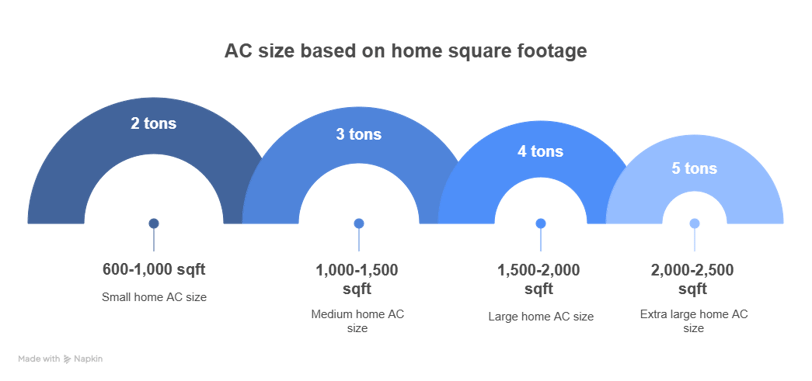Choosing the Right Size Refrigerated Air Unit for Your El Paso Home
5/23/20255 min read


Understanding the Basics of Refrigerated Air Units
A refrigerated air unit is a critical component of many home cooling systems, especially in regions like El Paso, where temperatures can soar during summer months. These units utilize a refrigeration cycle to extract heat from the indoor air, ensuring a cooler and more comfortable living environment. The fundamental operation involves the circulation of refrigerant, which absorbs heat from the indoor air and expels it outside, thereby lowering the indoor temperature.
These systems consist of several essential components, including a compressor, evaporator, condenser, and expansion valve. The compressor pressurizes the refrigerant, facilitating effective heat exchange. The evaporator absorbs the heat indoors, the condenser releases it outside, and the expansion valve regulates the flow of refrigerant, maintaining the cycle's efficiency. Together, these elements work harmoniously to ensure optimal performance of the refrigerated air unit.
Proper sizing of a refrigerated air unit is paramount for effective cooling. A unit that is too small may struggle to keep up with the heat, resulting in inadequate cooling and increased energy consumption. Conversely, an oversized unit can lead to rapid cycling, which not only reduces efficiency but also causes wear and tear on the system. Understanding key metrics such as BTUs (British Thermal Units) and tonnage is vital; these terms determine the cooling capacity required for a home based on its size and thermal load. A BTU measures energy and indicates how much heat a unit can remove from an area, while tonnage refers to the cooling capacity and is often used to describe larger systems.
Investing in a properly sized refrigerated air unit brings numerous benefits, including enhanced comfort, energy efficiency, and longevity of the system. Homeowners must thoroughly assess their cooling needs and conditions to ensure they select the most suitable unit for their residence in El Paso.
How to Choose the Right Size Refrigerated Air Conditioner for Your El Paso Home
Choosing the right size refrigerated air conditioner is crucial for maintaining comfort in your home while also ensuring energy efficiency. The correct sizing process begins with determining the total square footage of your living space. Measure the areas you wish to cool, including living rooms, bedrooms, and hallways. This measurement helps to establish a baseline of cooling capacity, usually measured in BTUs (British Thermal Units) per hour.
Additionally, the quality of insulation in your home significantly influences your air conditioning requirements. Homes with poor insulation allow cold air to escape, necessitating more powerful units to adequately cool the space. If your home has older windows that are not energy-efficient, it is important to factor that into your calculations. The number and size of windows, as well as their orientation, can also affect the overall heat gain during hot months. For instance, south-facing windows may require additional cooling power due to increased sunlight exposure.
Ceiling height is another important factor to consider when sizing a refrigerated air unit. Higher ceilings can lead to the need for a larger unit since the volume of air that needs to be cooled is greater. Also, assess other aspects of your home, such as the number of occupants and heat-generating appliances, which can influence the cooling load. For example, a home with multiple electronics and significant user activity may require more cooling capacity.
Lastly, it’s worth considering El Paso’s distinct climate when selecting the size of your refrigerated air conditioner. The area's extreme summer temperatures necessitate efficient cooling solutions, which may slightly alter the typical sizing recommendations. Consulting with a local HVAC professional can provide valuable insights tailored specifically to the climate and characteristics of your home, enabling you to make a well-informed decision.
Sizing Recommendations for Common Home Sizes in El Paso
When it comes to selecting the appropriate refrigerated air unit for your El Paso home, understanding sizing recommendations is crucial to ensure optimal cooling efficiency. The required heating or cooling output of an air conditioning system is typically measured in British Thermal Units (BTUs). For an average-sized home, various factors, including square footage, ceiling height, and insulation quality, affect the necessary BTUs, and consequently, the tonnage of the unit required.
For a typical 1500 square foot home in El Paso, homeowners should expect to utilize a system ranging from 3 to 4 tons, which translates to approximately 36,000 to 48,000 BTUs. This estimate serves as a general guideline; hence, it is vital to consider additional elements, such as the number of windows, orientation of the home, and local climate factors, which may necessitate a unit that leans towards the higher end of the spectrum for effective air conditioning. This is especially true during the hotter summer months when temperatures can be excessively high.
In a larger home of around 2000 square feet, the recommended tonnage increases to between 4 and 5 tons, equating to about 48,000 to 60,000 BTUs. Again, it is important to evaluate the specific conditions of the home, such as room layout and ventilation accessibility, as these factors may influence the needed capacity. Additionally, for houses with high ceilings, it is advisable to adjust the sizing accordingly. Higher ceilings often require more cooling power due to larger volumes of air that need to be cooled down effectively, thus it can be beneficial to consult with an HVAC professional to determine the best possible tonnage according to your unique living situation.
Choosing the Best Refrigerated Air Unit for Your Home's Unique Features
When selecting a refrigerated air unit for your home in El Paso, it is essential to consider various unique features that may impact your cooling needs. One significant factor is the height of your ceilings. Homes with higher ceilings will typically require units with a greater cooling capacity to ensure that air circulation effectively reaches all areas of the space. This is crucial in maintaining a consistent temperature throughout the home and preventing warm pockets of air from lingering near the ceiling.
Another critical aspect to take into account is the presence of large windows. Homes featuring expansive windows can experience higher heat gain from sunlight, increasing the demand for cooling. In such cases, homeowners can look into units with superior energy efficiency ratings, as these will help offset higher energy costs while maintaining comfort levels. Utilizing shades or reflective films on windows can also assist in alleviating some of the thermal load, enhancing the refrigerated air unit's performance.
The orientation of your home is also vital in determining the appropriate size and model of a refrigerated air unit. For instance, homes that face south or west may receive more direct sunlight, which will necessitate a powerful system to handle the additional heat. Conversely, properties with a north-facing aspect may require less cooling power. Understanding these characteristics will help homeowners identify suitable units that cater to their specific climate challenges.
Several units on the market boast excellent energy efficiency ratings, making them ideal options for environmentally conscious homeowners. Notable models include those with a Seasonal Energy Efficiency Ratio (SEER) rating above 16, which is recommended for optimal performance in areas like El Paso. By carefully evaluating the unique features of your home, you can successfully choose a refrigerated air unit that will perform efficiently while reducing your carbon footprint and energy expenses.


